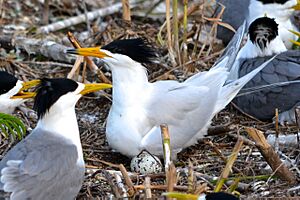Chinese crested tern facts for kids
Quick facts for kids Chinese crested tern |
|
|---|---|
 |
|
| A Chinese crested tern among greater crested terns | |
| Conservation status | |
| Scientific classification | |
| Genus: |
Thalasseus
|
| Species: |
bernsteini
|
| Synonyms | |
|
Sterna bernsteini Schlegel, 1863 |
|
The Chinese crested tern (Thalasseus bernsteini) is a special type of tern bird. It belongs to the Laridae family, which includes gulls and skimmers. This bird is so important that it's the official bird of Lienchiang County in Fuchien Province.
What Does It Look Like?
This tern looks a lot like its relatives, the Sandwich tern and the lesser crested tern. It is most similar to the Sandwich tern. The main difference is its beak: the Chinese crested tern has a yellow beak with a black tip. The Sandwich tern has the opposite pattern.
You can tell it apart from the lesser crested tern by its white lower back and lighter gray feathers on its back. It also has that black tip on its beak, which has a small white point when seen up close. The larger greater crested tern is also similar. But it has a thicker, all-yellow beak and darker gray feathers on its back and lower back. It's also bigger in size.
Where Does It Live and How Is It Protected?
The Chinese crested tern is a critically endangered species. This means it's very close to disappearing forever. For a while, people even thought it was extinct!
In 2000, only four pairs were found nesting. They were in a colony of greater crested terns. This was on a small island in the Matsu Islands, off the coast of Fujian Province, China. These birds spend their winters in the Philippines. In the past, they lived along more of the Chinese east coast, up to Shandong Province.
Scientists think the number of these birds dropped because people used to hunt them. They also collected their eggs for food. The small island where they were found might have helped protect them. This area was sensitive for military reasons, which limited access for people. This islet is now a wildlife sanctuary.
It's possible that other small groups of these birds might still be found. They could be along the Chinese and Taiwanese coasts. Some birds have been seen near the Pachang River in southern Taiwan. Experts believe there are fewer than 50 Chinese crested terns left in the world.
In 2007, experts worried the terns could become extinct in five years. This would happen if they weren't protected. BirdLife International said that the number of terns had fallen to 50 birds. This was half the number from 2004. A Chinese team said the bird was "on the verge of extinction."
Today, the terns are still in danger. People sometimes illegally collect their eggs. Strong storms called typhoons can also harm their nests. Fishermen can disturb their nesting areas. There's also a risk that they might breed with greater crested terns, which could change their unique features.
In 2016, something exciting happened. Chinese crested terns were found breeding in South Korea for the first time! Starting a new colony far away from their original home is great news for the species.
Sightings in the Philippines
This "bird of legend" was first seen in the Philippines in 1886. It was spotted again in 1905 in Manila Bay. It returned in 1937 and was seen again in March 2018. In November 2019, it was found along the coastal wetlands of Panabo, Davao del Norte, with other birds that travel long distances.
In August 2021, it was seen along the shores of Lingayen Gulf. Other rare birds were there too, like the Aleutian tern, Greater scaup, Lesser black-backed gull, and Slaty-backed gull.
Three Chinese crested terns were seen at the mouth of the Davao River in 2022. This was during a yearly count of migratory birds in Asia.
The Department of Environment and Natural Resources (Philippines) reported more sightings in January 2023. At least three birds were seen in Panabo City and Carmen, Davao del Norte. They were also seen in Bucana, Talomo District, Davao City, with other migratory birds like the Eurasian curlew and Far Eastern curlew. In December 2023, a tern was spotted along a sandbar near Paombong and Pamarawan Island in Malolos.


